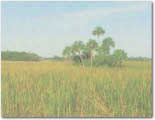Monitoring Sub-Aquatic Vegetation through Remote Sensing: A Pilot Study in Florida Bay
|
Project Investigators:
G. Lynn Wingard, Peter Chirico, Lawrence Handley
Project Personnel: Charles W. Holmes, James Murray, Marci Marot Project Start Date: 2003 End Date: 2004 |
| Summary |
| The objectives of this pilot study are to develop a methodology for monitoring spatial and temporal changes in sub-aquatic vegetation using remote sensing data, including satellite imagery and aerial photography, and to analyze potential causes of seagrass die-off using geographic, geologic and biologic tools. |
Seagrass beds are essential components of any marine ecosystem because they provide feeding grounds, nurseries, and habitats for many forms of marine life, including commercially valuable species; they are important foraging grounds for migratory birds; and they anchor sediments and impede resuspension and coastal erosion during storms. This valuable natural resource has been suffering die-offs around the world in recent years, yet the causes of these die-offs are undetermined. The purpose of this project is to use a number of tools - geographic, geologic, and biologic - to investigate the causes of seagrass die-offs and to develop methods that can be used to monitor the health of seagrass meadows. If we understand the causes of the die-offs and can easily monitor the health of seagrass beds, then resource managers have a tool for forecasting areas of potential die-offs. This pilot study will focus on Florida Bay, a region that suffered the loss of 40,000 ha of turtle grass in a die-off event that began in 1987, and a small, localized die-off in 1999. These events were well documented and provide a baseline for testing methods of monitoring grass beds remotely. Remote sensing data, including aerial photos and satellite imagery data, and data extracted from sediment cores will be used to examine the long-term sequences of events leading up to seagrass die-off events. An understanding of the sequence of events that precede die-offs is critical for resource managers, so further losses can be effectively prevented, and damaged systems can be restored.
Work Plans
Project Summaries
Data
- Ecosystem History of South Florida Estuaries Data (from the data exchange pages)
Metadata
- Monitoring Sub-aquatic Vegetation Through Remote Sensing: a Pilot Study in Florida Bay (project metadata)
- Ecosystem History of South Florida Estuaries Data (data set metadata)
Publications
Abstracts
- Evidence of Freshwater Influx into Rankin Basin, Central Florida Bay, Everglades National Park, Prior to 1900 (from the GEER Conference, April 2003)
Information Sheets
Open File Reports
- Preliminary Report on the Distribution of Modern Fauna and Flora at Selected Sites in North-central and North-eastern Florida Bay (Open-File Report 96-0732)
Posters
- Historical Trends in Epiphytal Ostracodes from Florida Bay: Implications for Seagrass and Macro-benthic Algal Variability (please note that this is a 2.0 MB PDF file and requires the FREE Adobe Acrobat Reader® to be read)
- Lignin Phenols from Sediments of Florida Bay as Indicators of Seagrass History (from the USGS Water Quality Workshop, October 2000)
- Reconstructing the History of South Florida's Ecosystem: The Role of Modern and Paleoecological Data (Penrose Conference 1998, please note that this is a 2.5 MB PDF file and requires the FREE Adobe Acrobat Reader® to be read)

